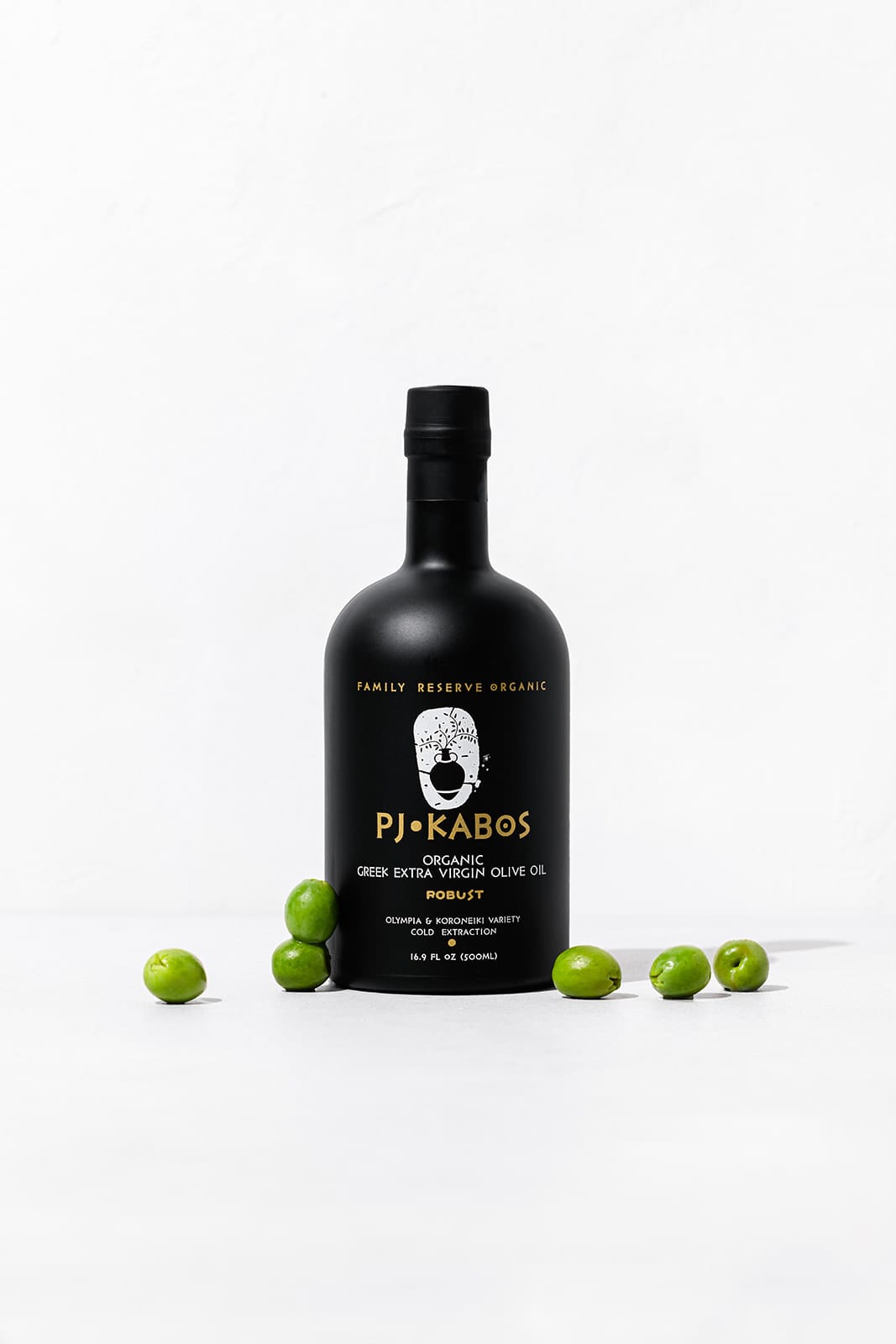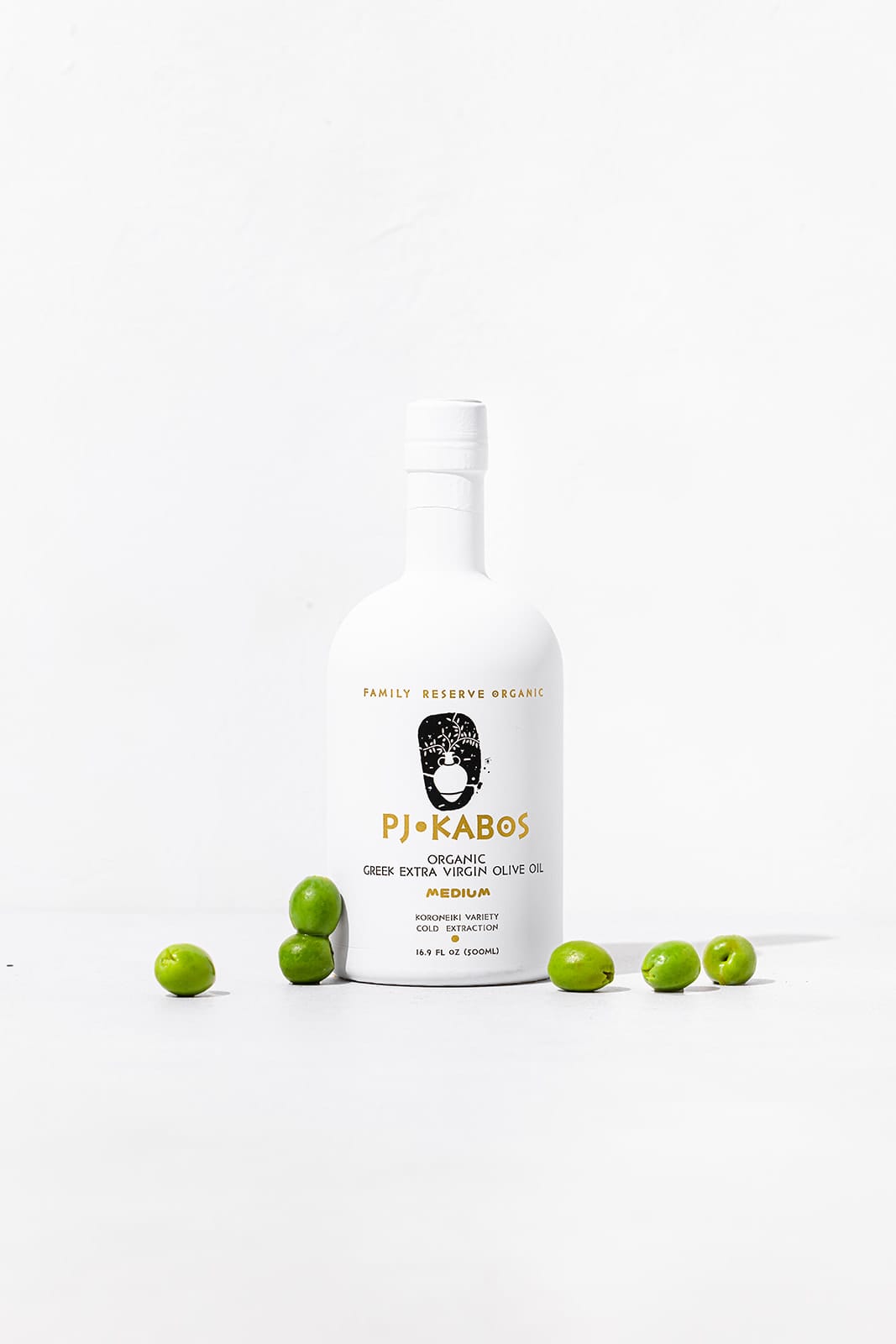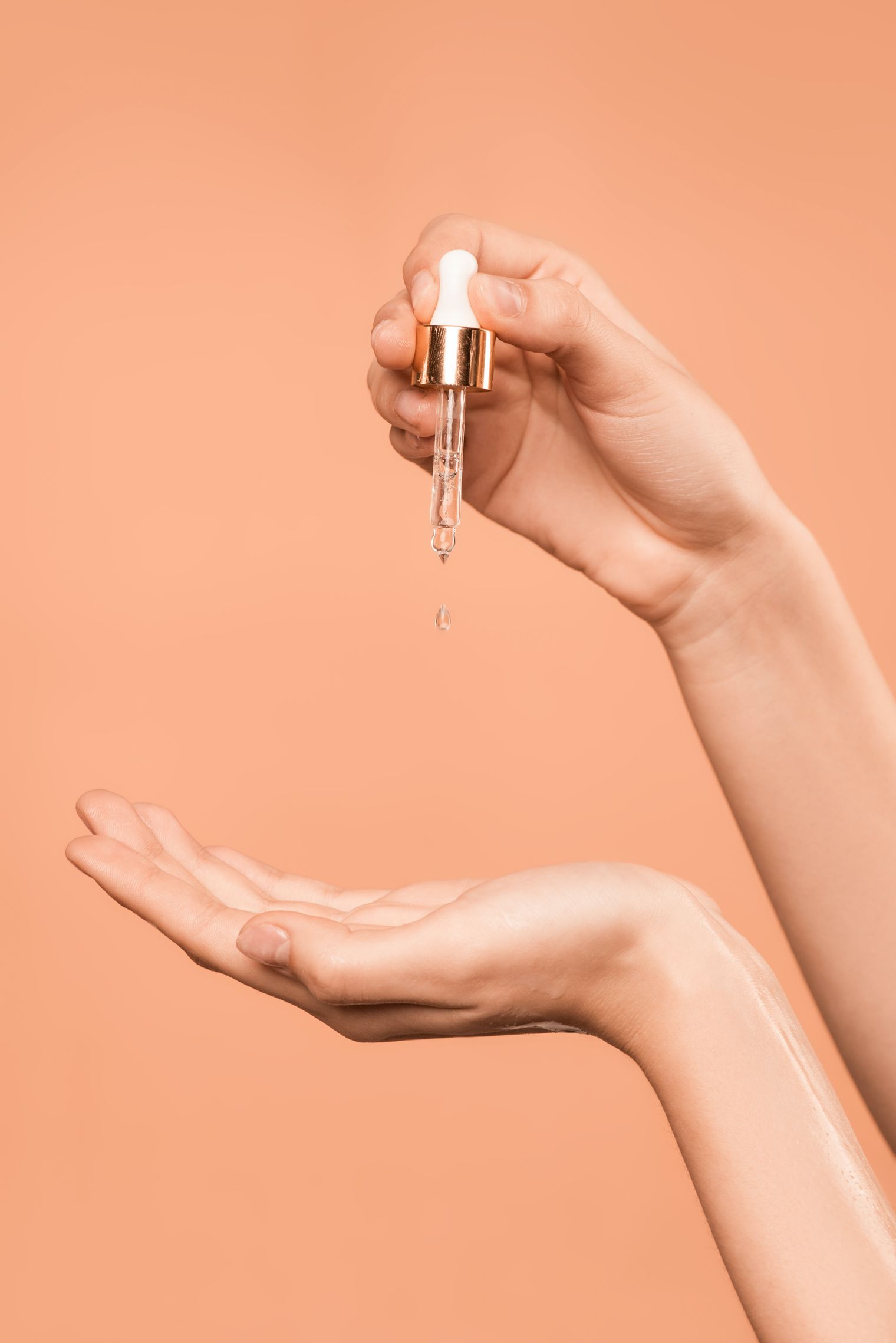It is fascinating to ponder that all food is composed of chemical compounds. Whether it is fruits, vegetables, grains, meat, or any other type of food, everything we consume is a complex mixture of carbohydrates, proteins, fats, vitamins, minerals, and various bioactive compounds.
PJ Kabos is dedicated to promoting conscious living and environmentally-friendly practices to foster sustainability.
These components, made up of atoms and molecules, interact through chemical reactions with your body to provide the essential nutrients and energy required by you to function correctly.

Phenolic Compounds, Phenols, Polyphenols in Olive Oil
When making informed decisions for you and your family, understanding the intricate world of health benefits associated with Extra Virgin Olive Oil is paramount. Three terms that are frequently mentioned in relation to the healthfulness of Extra Virgin Olive Oil are "phenolic compounds,“ "phenols,” and "polyphenols."
But what exactly are these and what do they mean for you when buying olive oil?
What are Phenolic Compounds?
Phenolic compounds are a class of chemical compounds that contain one or more phenol groups. They can be simple or polyphenols. These compounds can vary in complexity, ranging from simple phenols, which contain a single phenol group, to polyphenols, which contain multiple phenol groups.
To grasp what phenolic compounds are, let’s take a moment to revisit high school chemistry and do a quick investigation of the intricate structures of these fascinating chemical compounds that have a real-world, and very important application for you and your health.

Simple Phenols
Chemically speaking, simple phenols are organic compounds characterized by the presence of a hydroxyl (-OH) group attached to an aromatic or benzene ring structure. Their characteristics are:
- Typically consist of a single phenolic unit, with a single hydroxyl group bonded directly to the aromatic ring.
- The aromatic or benzene ring is made up of six carbon atoms arranged in a circle.
- The hydroxyl group is composed of an oxygen atom bonded to a hydrogen atom and is what distinguishes phenols from other organic compounds.
- Within the aromatic ring, each carbon atom is connected to neighboring carbon atoms in a specific way, forming a stable structure.
So what this means is that in a typical phenol, there's only one aromatic ring, and attached to it is a hydroxyl group. So, you have this ring with a special group—the hydroxyl group—hanging off it, which gives phenols their distinctive properties.
Phenols are organic compounds characterized by a hydroxyl (-OH) group attached to an aromatic or benzene ring structure.
Alright, enough chemistry for the moment! Let's switch gears back to everyday language. While we often encounter simple phenolic compounds in items like disinfectants and household cleaners, our focus here is on the phenols found in the foods we eat.
Phenols Found in Food
In the world of food, phenolic compounds primarily manifest as secondary metabolites of vegetables and other plant-based foods. These phenolic compounds often take on polymeric forms, collectively known as polyphenols.
Secondary metabolites are organic compounds in plants not essential for basic functions; serve specialized roles like defense and attraction.
Secondary metabolites in olive oil are organic compounds not essential for the basic physiological functions; they serve specialized roles, such as contributing to flavor, providing health benefits, and aiding in defense mechanisms.
What are Polyphenols?
Polyphenols are a subgroup of phenols and a larger and more complex group of compounds composed of multiple phenolic units. Unlike simple phenol compounds, polyphenols are more intricate. They contain multiple phenolic ring structures, each with at least one hydroxyl group.
The term, “polyphenols,” originated from the Ancient Greek word “polus,” meaning “many” and “phenol”—many-phenols.
So, the main difference between a simple phenol and a polyphenol is the number of phenolic ring structures they contain. Simple phenols have one, while polyphenols have multiple. This difference in structure gives polyphenols their unique properties and behavior, making them more complex.
Polyphenols contain multiple phenol groups; "typically contain one or more aromatic rings with hydroxyl groups (-OH) attached to them" [1]
Antioxidant and Other Biological Benefits
It’s the presence of multiple phenolic ring structures, each containing at least one hydroxyl group, that contributes to the health benefits associated with polyphenols.
Due to their chemical structure, polyphenols possess antioxidant and other biological activities, which allows them to scavenge free radicals and modulate various cellular pathways. The hydroxyl groups attached to the phenolic rings play a crucial role in these activities by literally donating hydrogen atoms to neutralize free radicals and by interacting with enzymes and other proteins in the body. This significant contribution to human health is why there's so much excitement surrounding the presence of polyphenols in high-phenolic extra virgin olive oil.
It is the presence of multiple phenolic ring structures, each containing hydroxyl groups, that contributes to the antioxidant and other biological activities associated with polyphenols.
Where Do We Find Polyphenols?
Nature, in its infinite diversity, bestows us with a plethora of polyphenols found in various plant sources. Fruits like olives, vegetables, whole grains, nuts, seeds, and even beverages such as tea and coffee serve as abundant reservoirs of these compounds. "There are more than 8000 different polyphenolic structures known, including several hundred isolated from edible plants."[2] It is this remarkable diversity that contributes to the multifaceted roles polyphenols play in the natural world.

What are Phenolic Compounds in Olive Oil Good for?
Olive oil is rich in phenolic compounds, both simple and in polymeric form, including such well-known chemical names as hydroxytyrosol, tyrosol, oleacein, oleocanthal, ligstroside, oleuropein aglycones, pinoresinol, etc..
Okay...but what do they do for the human body?
Listen to what just one study says about hydroxytyrosol: "Hydroxytyrosol is a phenolic compound drawn from the olive tree and its leaves as a by-product obtained from the manufacturing of olive oil. It is considered the most powerful antioxidant compound after gallic acid and one of the most powerful antioxidant compounds between phenolic compounds from olive tree followed by oleuropein, caffeic and tyrosol. Due to its molecular structure, its regular consumption has several beneficial effects such as antioxidant, anti-inflammatory, anticancer, and as a protector of skin and eyes, etc." [3]
As this study and the following quote from another clearly show, ongoing modern scientific research has uncovered a multitude of benefits of olive oil that is high in phenolic content. From providing antioxidant and anti-inflammatory properties to supporting cardiovascular, neuroprotective, dermal, hormonal, digestive, and hematological health, phenolic compounds offer a broad spectrum of advantages.
"Polyphenols were determined to reduce morbidity and/or slow down the progression of cardiovascular, neurodegenerative, and cancer diseases. The mechanism of action of polyphenols strongly relates to their antioxidant activity. Polyphenols are known to decrease the level of reactive oxygen species in the human body. Other than that, health-promoting properties of plant polyphenols comprise anti-inflammatory, anti-allergic, anti-atherogenic, anti-thrombotic, and anti-mutagenic effects. There is a body of research presenting their ability to modulate the human immune system by affecting the proliferation and activity of white blood cells, as well as the production of cytokines or other factors that participate in the immunological defense." [4]
In truth, the phenolic compounds found in high-quality extra virgin olive oil offer a diverse range of specialized benefits, with each compound uniquely contributing to various aspects of human health. And each is its own amazing subject.

The Scientific Research Continues
As we continue to unlock the secrets of these remarkable compounds through scientific research, let’s relish in the delightful flavors of foods enriched with this ancient elixir, appreciating high-phenolic extra virgin olive oil's multifaceted properties as a tribute to the timeless harmony between nature's gifts and human well-being. And be grateful that something so good for us, adds such wonderful flavors to our foods.
In the video below are a few delicious dishes we at PJ Kabos particularly love. All are made with high-phenolic extra virgin olive oil and taste fabulous!
A few delicious dishes made using PJ Kabos High-Phenolic Extra Virgin Olive Oil. Enjoy!
Please enjoy having a look around our websites, pjkabos.com and oliveoil.com, as well as our Amazon Store for more about our many high-phenolic olive oils, recipes, etc. And follow along with us on Instagram for photos concerning olive oil production, our groves in Greece, news stories, family history and more.
PJ KABOS is a top, on-line seller of High-Phenolic Extra Virgin Olive Oil. It is: "For those who want to be good to their bodies."
High-Phenolic Extra Virgin Olive Oil from PJ Kabos
PJ Kabos Family Reserve—Robust (Black Bottle)

PJ KABOS Family Reserve Organic - Robust, is an extra virgin olive oil that is very high in polyphenols and adds depth, character and great health benefits to every meal.
PJ Kabos Family Reserve Organic—Medium Taste (White Bottle)

PJ KABOS Family Reserve Organic - Medium, is an extra virgin olive oil that is high in polyphenols and adds a lovely taste and great health benefits to every meal.
PJ Kabos Family Reserve—Medium Taste (White Tin)

PJ KABOS Family Reserve - Medium, is an extra virgin olive oil in an easy-to-store tin that is high in polyphenols and adds a lovely taste and great health benefits to every meal.
Please note: This article is for informational purposes only and should not be considered medical advice. Consult a healthcare professional for personalized guidance regarding your health and medical conditions.
[1] Monika Gorzynik-Debicka, Paulina Przychodzen, Francesco Cappello, Alicja Kuban-Jankowska, Antonella Marino Gammazza, Narcyz Knap, Michal Wozniak, and Magdalena Gorska-Ponikowska (2018). Potential Health Benefits of Olive Oil and Plant Polyphenols. National Institutes of Health. https://www.ncbi.nlm.nih.gov/pmc/articles/PMC5877547/
[2] ibid.
[3] Lorena Martínez, Gaspar Ros, and Gema Nieto (2018). Hydroxytyrosol: Health Benefits and Use as Functional Ingredient in Meat. National Institutes of Health. https://www.ncbi.nlm.nih.gov/pmc/articles/PMC5874578/
[4] Monika Gorzynik-Debicka, Paulina Przychodzen, Francesco Cappello, Alicja Kuban-Jankowska, Antonella Marino Gammazza, Narcyz Knap, Michal Wozniak, and Magdalena Gorska-Ponikowska (2018). Potential Health Benefits of Olive Oil and Plant Polyphenols. National Institutes of Health. https://www.ncbi.nlm.nih.gov/pmc/articles/PMC5877547/



